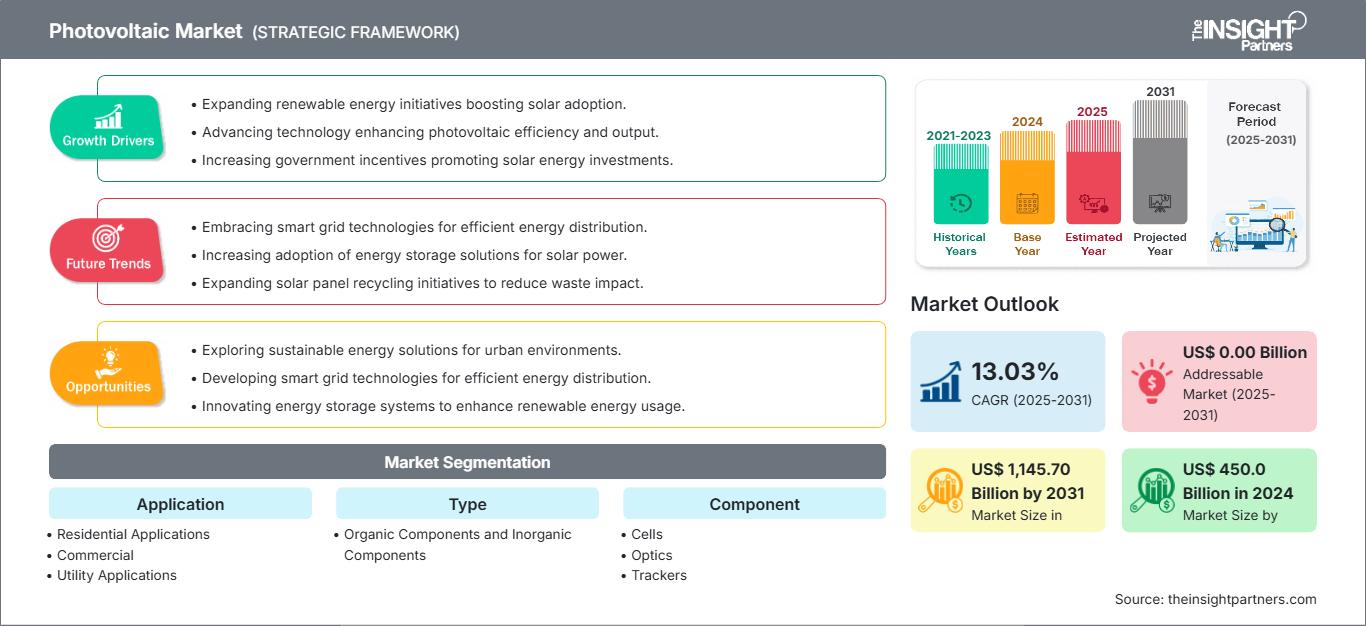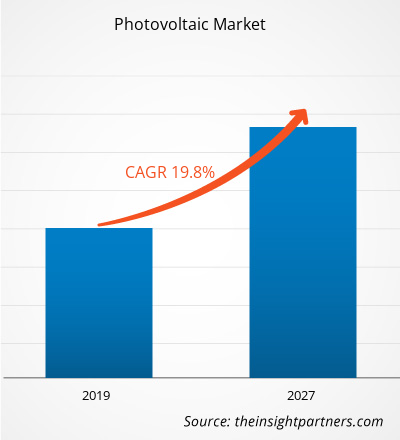La taille du marché photovoltaïque devrait atteindre 1 145,70 milliards de dollars américains d'ici 2031, contre 450,0 milliards de dollars américains en 2024. Le marché devrait enregistrer un TCAC de 13,03 % entre 2025 et 2031.
Dans le sillage du développement technologique et de l'accent mis sur une tendance croissante de la technologie solaire photovoltaïque, les gouvernements allemand et espagnol ont établi des cadres politiques solides tels que des objectifs nationaux clairs, des incitations attrayantes pour promouvoir la consommation et des plans intégrés pour stimuler le développement technologique et l'adoption de la technologie photovoltaïque dans l'énergie solaire et stimuler la croissance du marché photovoltaïque. Dans la région APAC, plusieurs initiatives ont été prises par les gouvernements pour minimiser le coût de l'installation globale afin de maximiser les avantages à grande échelle d'une option hors réseau dans l'électrification rurale, tout en mettant l'accent sur les conditions environnementales durables. De plus, plusieurs pays, comme la Chine, ont mis en place des politiques visant à accroître la production d'énergie solaire photovoltaïque. Ainsi, les facteurs mentionnés ci-dessus contribuent à la croissance du marché photovoltaïque. L'énergie photovoltaïque (PV) connaît une croissance rapide et contribue de manière significative au bilan énergétique des systèmes électriques de l'économie. Ces systèmes se sont imposés comme une technologie mature utilisée pour la production d'électricité grand public et stimulent la croissance du marché photovoltaïque. Cependant, les systèmes photovoltaïques solaires produisent un excédent d'électricité. Les fournisseurs d'électricité du monde entier pratiquent la facturation nette, un système par lequel l'excédent d'électricité produit par les systèmes d'énergie renouvelable connectés au réseau est reversé au compteur électrique. Cela évite le gaspillage et améliore la distribution d'énergie en fonction des besoins. Les systèmes photovoltaïques utilisant la technologie du réseau représentent environ 99 % de la capacité installée, par rapport aux systèmes autonomes, qui nécessitent des batteries. Le photovoltaïque sans batterie connecté au réseau est considéré comme une solution rentable et nécessite moins de maintenance, ce qui favorise l'adoption de produits photovoltaïques et stimule ainsi la part de marché du photovoltaïque.
De plus, pour les personnes qui optent pour des panneaux solaires, les systèmes photovoltaïques connectés au réseau sont considérés comme une option rentable pour répondre à l'ensemble de leurs besoins électriques. De plus, l'installation de systèmes autonomes est une tâche fastidieuse et nécessite davantage de capitaux et d'espace que celle des systèmes photovoltaïques connectés au réseau. Ainsi, l'adoption croissante des systèmes photovoltaïques connectés au réseau stimulera davantage la croissance du marché photovoltaïque. De plus, avec l'intérêt croissant pour les énergies renouvelables et la tendance aux économies d'énergie, les systèmes photovoltaïques connectés au réseau s'avèrent une option économiquement viable. Cependant, leur applicabilité est encore limitée pour le moment et pourrait s'accroître dans les années à venir.
Vous bénéficierez d’une personnalisation sur n’importe quel rapport - gratuitement - y compris des parties de ce rapport, ou une analyse au niveau du pays, un pack de données Excel, ainsi que de profiter d’offres exceptionnelles et de réductions pour les start-ups et les universités
Marché du photovoltaïque: Perspectives stratégiques

-
Obtenez les principales tendances clés du marché de ce rapport.Cet échantillon GRATUIT comprendra une analyse de données, allant des tendances du marché aux estimations et prévisions.
Aperçu du marché photovoltaïque : Utilisation croissante des peintures photovoltaïques pour exploiter l'énergie solaire
La volatilité des prix du pétrole brut, les préoccupations environnementales liées à l'hydroélectricité et les risques liés aux radiations nucléaires ont déplacé la charge de la satisfaction de la demande énergétique vers l'énergie solaire. Les progrès technologiques, l'accent mis sur la réduction des coûts d'installation et l'utilisation rapide de la technologie photovoltaïque dans les applications résidentielles comptent parmi les facteurs qui redéfinissent son utilisation. À l'ère de l'utilisation croissante de l'énergie solaire, l'introduction des peintures solaires est devenue une avancée remarquable. Les peintures solaires, communément appelées peintures photovoltaïques, peuvent être appliquées sur n'importe quelle surface pour capter l'énergie du soleil et la convertir en électricité. Les composants de la peinture sont combinés à des milliards de particules de matériau photosensible en suspension, ce qui pourrait contribuer à transformer une peinture classique en une peinture superpuissante capable de capturer l'énergie. L'utilisation de peintures photovoltaïques permet de réduire efficacement la dépendance aux métaux et de combiner le principe de la diode à jonction pn et l'effet thermoélectrique pour produire de l'énergie électrique à partir de l'exposition au soleil. Cela favorisera l'adoption de l'énergie solaire et, à terme, propulsera la croissance du marché photovoltaïque. Des entreprises comme Onyx Solar Group LLC visent le développement de cette technologie en se concentrant sur la R&D et en collaborant avec des instituts pour développer des peintures photovoltaïques et ainsi stimuler la croissance du marché. Bien que les peintures solaires, ou la technologie de la peinture photovoltaïque, en soient encore à leurs balbutiements, elles devraient gagner en popularité dans un avenir proche. Avec la progression et les progrès de l'industrie solaire, les peintures solaires ont d'excellentes chances de devenir une option raisonnable. Ainsi, les facteurs mentionnés ci-dessus créent une opportunité pour le marché photovoltaïque.
Aperçu régional du marché photovoltaïque
Les tendances régionales et les facteurs influençant le marché photovoltaïque tout au long de la période de prévision ont été analysés en détail par les analystes de The Insight Partners. Cette section aborde également les segments et la géographie du marché photovoltaïque en Amérique du Nord, en Europe, en Asie-Pacifique, au Moyen-Orient et en Afrique, ainsi qu'en Amérique du Sud et en Amérique centrale.
Portée du rapport sur le marché photovoltaïque
| Attribut de rapport | Détails |
|---|---|
| Taille du marché en | US$ 1,145.70 Billion by 2031 |
| Taille du marché par | US$ 450.0 Billion in 2024 |
| TCAC mondial (2025 - 2031) | 13.03% |
| Données historiques | 2021-2023 |
| Période de prévision | 2025-2031 |
| Segments couverts |
By Application
|
| Régions et pays couverts |
Amérique du Nord
|
| Leaders du marché et profils d'entreprises clés |
|
Densité des acteurs du marché photovoltaïque : comprendre son impact sur la dynamique des entreprises
Le marché du photovoltaïque connaît une croissance rapide, portée par une demande croissante des utilisateurs finaux, due à des facteurs tels que l'évolution des préférences des consommateurs, les avancées technologiques et une meilleure connaissance des avantages du produit. Face à cette demande croissante, les entreprises élargissent leur offre, innovent pour répondre aux besoins des consommateurs et capitalisent sur les nouvelles tendances, ce qui alimente la croissance du marché.

- Obtenez le Marché du photovoltaïque Aperçu des principaux acteurs clés
- Analyse historique (2 ans), année de base, prévision (7 ans) avec TCAC
- Analyse PEST et SWOT
- Taille du marché Valeur / Volume - Mondial, Régional, Pays
- Industrie et paysage concurrentiel
- Ensemble de données Excel
Rapports récents
Témoignages
Raison d'acheter
- Prise de décision éclairée
- Compréhension de la dynamique du marché
- Analyse concurrentielle
- Connaissances clients
- Prévisions de marché
- Atténuation des risques
- Planification stratégique
- Justification des investissements
- Identification des marchés émergents
- Amélioration des stratégies marketing
- Amélioration de l'efficacité opérationnelle
- Alignement sur les tendances réglementaires






















 Obtenez un échantillon gratuit pour - Marché du photovoltaïque
Obtenez un échantillon gratuit pour - Marché du photovoltaïque